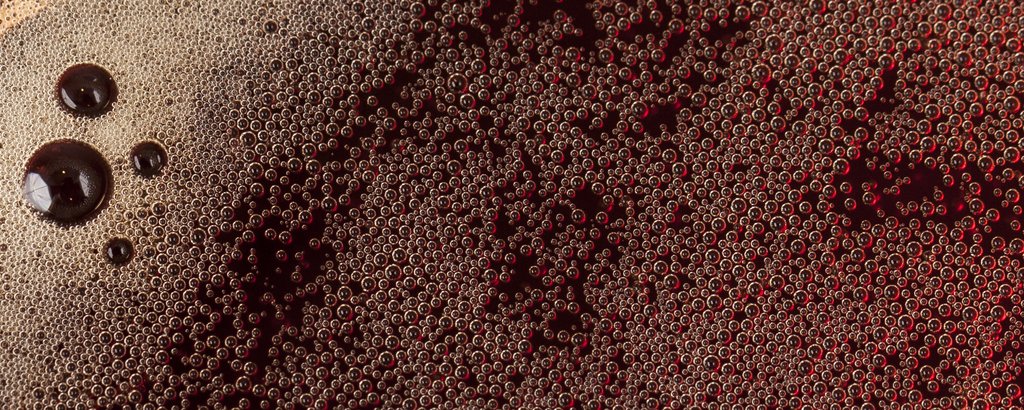

Fizzy cold brewed coffee? There's a few commercial cold brewed coffees emerging on the on market, and we thought carbonating some cold brew of our own could be an interesting experiment. Anyone that's drank soda that's gone flat knows what a significant role carbonation plays in how it tastes. Bringing that added ZING to cold brew could be a welcomed addition to an already refreshing beverage.


Carbonation:
You can carbonate just about anything. Seriously. Even ice-cream! On top of that, there's numerous ways to carbonate. Carbonation is the process of dissolving carbon dioxide (CO2) gas into a liquid. To do this, an air-tight container with liquid is pressurized with carbon dioxide, and the pressure forces the carbon dioxide to dissolve into the liquid. When the container is opened (de-pressurized) the dissolved CO2 comes out of solution forming bubbles and creates the fizz we're familiar with.
The two primary methods to carbonate are:
Forced Carbonation
Natural Carbonation
Forced carbonation Set-up (pictured left)
In forced carbonation shown above, CO2 is supplied by a highly pressurized cylinder containing the gas. This is the method I use when carbonating my home brewed beer, and it's the method used by the popular sodastream soda maker. Unfortunately, it's a bit equipment-intensive...
Natural Carbonation Set-up (pictured right)
In natural carbonation, yeast is introduced to the liquid. As these microorganisms converts the fermentable sugars in the liquid, CO2 is produced as a by-product. Alcohol is another by-product. However, due to the relatively short fermentation time required to carbonate, you can expect less than 1% alcohol content.
Natural carbonation requires very little in the way of equipment (as shown in the picture above), so we're going to use this method to carbonate our cold brew in this experiment. I've adapted the below recipe from a really great book on making home-made sodas called True Brews. The recipe can be found here.


What you need:
- 16oz cold brew coffee at room temp.
- 1/32 teaspoon Dry Champagne yeast (~0.1 grams)
- 0.9 oz of granulated sugar
- 16-20 oz empty plastic soda bottle
Note: Champagne yeast can be found at your local home brew supply stores or on Amazon. The amount required is minuscule for a 16oz batch. It's a little difficult to measure if you don't have a gram scale and I don't think 1/32 sized measuring teaspoons are even made, but just a pinch of it between your fingers should be about right. Also, champagne yeast is chosen for it's taste neutrality.
Note: White granular sugar is used to give the yeast something to ferment. The amount you use will influence the final sweetness of the carbonated cold brew.
Method:
- Add the cold brew to the yeast and sugar in the bottle. Leave about 1 inch of headspace at the top.
- Seal container and shake!
- Leave in warm location for 12-48 hours.






After some time, you'll notice the increasing pressure in the bottle when you try to squeeze the sides. The firmness is a good gauge of how carbonated your cold brew will be. Once it's nice and firm, you can put it in the refrigerator to stop the fermentation process and prevent it from over carbonating.
After about 18 hours, our bottle had become firm to the squeeze, so we opened it up and poured ourselves a cup of cold brew. Compared to a soda, It was lightly carbonated, which gave it an interesting effervescent mouth feel. Very different from the cold brew we're used to drinking.
That fizzy-ness definitely gave it more of a bite. That smooth, less acidic taste we're familiar with seemed to be supplanted by the carbonation. In this batch, we definitely noticed the added sweetness from the sugar. It was a little too sweet for my tastes, and I'd try using less sugar in the next batch, or I'd let it ferment longer (at the risk of over-carbonating).
Bottom line
This makes for a super easy way to experiment with carbonated cold brew. I'd recommend trying it out. It's definitely not how i'd like to drink cold brew every day, but I could see it being a nice change once in a while. It could be interesting to start adding some other ingredients so that the cold brewed coffee is playing a more supporting role. Maybe something alcoholic? What ever it is, I'd probably leave the milk out of it though.
Let us know how your experiments turn out!